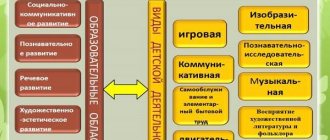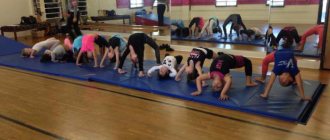The structure of writing a GCD summary in a preschool educational institution according to the Federal State Educational Standard
Municipal budgetary preschool educational institution
Kindergarten No. 12 “Bell”
Consultation for teachers
The structure of writing a GCD summary in a preschool educational institution according to the Federal State Educational Standard
The structure of writing a GCD summary in a preschool educational institution according to the Federal State Educational Standard
With the introduction of the Federal State Educational Standard, the approach to organizing and conducting direct educational activities with children is changing.
There is a rejection of traditional classes built in the logic of the educational model. The lesson is understood as an exciting activity with children, during which the teacher solves program problems. The role of the teacher is being rethought, becoming more of a “coordinator” or “mentor” than a direct source of information.
The position of a preschool teacher in relation to children changes and takes on the nature of cooperation when the child acts as an equal partner in a situation of joint activity and communication with the teacher.
Many teachers do not pay attention to the design of notes. The topic, purpose, and objectives are written in the notes. And often tasks pass through the goal.
Let's remember how this is done.
Let's start with the title page
The full name of the preschool institution is indicated at the top of the title page. Approximately in the middle of the sheet there is an inscription:
Abstract
Direct educational activities in (Region)
On the topic of: "……………"
for older children.
Below the title of the abstract, the author's surname and position are indicated on the right.
At the end of the title page, in the middle, your locality is written, and even lower, the year when the summary was written.
Next sheet
starts with program content.
This includes the purpose and objectives of the GCD.
What is a goal?
The goal is the end result, what we strive for. The goal is achieved through tasks, which in relation to the goal are means, i.e. how we will achieve this goal. It is recommended that the goal be determined by a noun from a verb: creating conditions, forming, educating, strengthening, etc.
Goal setting algorithm:
- Assess the existing problems and identify the main one, clearly formulate it.
- Determine the steps (actions) to solve it and their sequence.
- Formulate exactly the intermediate result (effect) from the execution of each step (action).
- Evaluate which (and how many) of these steps (actions) can be carried out within the framework of one GCD.
- Formulate the goal of the GCD, which contains a description of the effect of the actions that you plan to carry out within the framework of one GCD.
What an adult proposes to do must be necessary and interesting for the child, and the meaningfulness for the child of the activity proposed by the adult is the main guarantee of the developmental effect.
A task
is something that requires execution or solution.
Tasks in relation to the goal are and are:
Educational;
Developmental;
Educating.
It is recommended to formulate tasks with a verb in an indefinite form: consolidate, generalize, form, develop, educate, etc. Maintain clarity and specificity in the formulation of tasks (not just expand (consolidate) ideas about winter, but what exactly children learn (reinforce) about winter within the framework of this lesson). This also applies to the formulation of developmental tasks: not just the development of children’s mental abilities, but which ones specifically (list).
It should be remembered that each new task is written on a new line.
When the tasks are formulated, it is necessary to indicate what equipment
will be used on this GCD (for example: tape recorder, board, easel, wall board, cubes, stands, etc.).
The following is the demonstration material:
where not only all manuals and paintings are listed, but also their authors, quantity, and sizes are indicated.
Describing the handout material,
It is necessary to list what material is taken, indicating the size and quantity.
Next, it is necessary to describe the teacher’s previous work
in preparation for the lesson:
what was designed, what was produced, what was compiled, studied, written, etc. After this, preliminary work with children
, the entire scope of frontal and individual work with children (where they went on an excursion, what object they observed, what they read to the children, what they learned, etc.)
After this, it is written what individual work,
with whom (indicate the names and surnames of the children) in what part of the lesson it is planned to take place.
It is advisable not to forget to include this work in the part of the lesson in the notes in which you planned.
The following describes the structure
and
methodological techniques
used in the lesson.
The parts of the lesson and specific methodological techniques are indicated.
The summary also includes vocabulary work.
- these are new words, the meaning of which must be explained to children.
The parts of the lesson and specific teaching techniques are indicated.
.
The following describes the organization of children in direct educational activities.
The placement of tables, equipment, seating and placement of children is indicated - if necessary, a placement plan is included.
If the placement of children in different parts of the lesson changes, describe how the transition from one part of the lesson to another is carried out. And finally, a description of the course of the lesson
.
The course of the lesson is written in direct speech. Be sure to write down all the words that the teacher will say, the expected answers of the children, and the teacher’s generalizations.
If during the lesson the teacher needs to perform some actions, this is indicated in the notes. The lesson ends with words of analysis.
So, if we briefly describe all of the above,
the structure of the abstract is as follows:
- Type, type, topic of GCD indicating the age group of children
- Program content
(training, developing, educating tasks).
- Vocabulary work.
- Class equipment.
- Demonstration material.
- Handout.
- Previous work of the teacher in preparation for the lesson.
- Preliminary work with children
(with the whole group, with a subgroup, individually).
- Individual work with children on educational activities
(which one, with whom, in what part of the lesson).
- Lesson structure and methodological techniques.
- Organization of children in the classroom.
- Progress of the lesson (in direct speech).
At the end there are final phrases or analysis of the lesson.
We remind you about the types of classes:
1. Classes on communicating new knowledge. 2. Classes to consolidate knowledge, skills and abilities. 3. Lessons on generalization and systematization. 4. Final. 5.Accounting and verification. 6. Combined (mixed, combined). 7. Complex. 8. Integrated
(based on the principle of combining several types of children's activities and different means of speech development).
Integration can be on a thematic basis.
For example:
1) reading about birds; 2) collective drawing of birds; 3) storytelling based on pictures.
Additional Information
Do not forget about the methodological support of the pedagogical process. Any activity begins with a motive.
Motive
is a reason that motivates action. Previously, we called a motive a moment of interest before a lesson.
The following motives for activities for children are distinguished:
Gaming.
A child can realize his need for significance by “helping” various toys solve their practical and intellectual problems.
Motivation for communication.
Motivation is based on the child’s desire to feel necessary and important in helping an adult. An adult turns to a child with a request to help him, he says that there is no way to do without the child’s help. At the same time, he does not forget to thank the child.
Self-interest motivation.
This motivation encourages the child to create various objects for his own consumption.
After motivation comes the methodology for conducting the lesson. This section should highlight the parts of the lesson. Children's answers are not written in notes.
How to correctly develop a summary of direct educational activities according to the Federal State Educational Standard
Dear colleagues, I offer an approximate example of a summary of direct educational activities. This does not mean that the entire country should write this way. Each region may have its own note-writing traditions . The most important thing is that the notes must reflect current trends in the development of preschoolers and be methodologically correct.
First of all, it should be noted that there is currently no clear replacement for the word “occupation”. In some regions it is called “direct educational activity” (DEA), in others – “organized educational activity” (OOA), in still others – “educational situation” (OS). All these definitions are correct, as they reflect specific educational activities. But in defense of the word “occupation,” I want to say that preschool teachers have always put a slightly different meaning into this concept than, for example, school teachers. Our lesson was held in a playful way, with various problematic situations, surprise moments and good physical activity of the pupils. There has never been a purely educational activity in kindergarten!
So, summary: 1. Title. It is not necessary to write the name of the educational activity in the title (for example, a summary of the educational activity “Visiting Parsley”). You can simply indicate the direction of activity (“Summary of direct educational activities on cognitive development”). Write the age (group) of the children (for children of senior preschool age).
2. After the title, you can indicate the priority educational area in the GCD process and, preferably, integration with other educational areas , as well as the integration of children's activities.
3. The forms of organizing collective activities are indicated (work in subgroups, in pairs, joint activities of the teacher with children) and independent activities of children (if planned).
4. Further indicate: material and equipment; preliminary work; planned results.
5. Tasks. I would like to immediately warn teachers against making mistakes. Some colleagues write: “ GCD goals This is methodologically incorrect. The goal is the final and overall result, extended over time. What goal can be achieved, for example, in 15 minutes of educational activity in a younger group? It is more correct to write the word “goal”, for example, when developing planning for a complex (i.e., several) GCD, when developing a project (since it is multifaceted) and other time-extensive complexes of educational activities . Moreover, there is only one goal, but there can be many tasks. And for a specific educational activity, specific tasks are suitable that must be solved by the end of this educational activity (after 15 minutes in the junior group or after 35 minutes in the preparatory group). That is, if a teacher wrote a problem in the GCD notes, then he must solve it in the GCD process . Therefore, do not write 10-15 problems in your notes. Five, maximum six is enough. You can replace the word “tasks” with the phrase “program content”. Do not write the verb “teach” ! It is more correct to write “to promote”, “to form skills”, “to create conditions”, “to develop”, “to involve”, etc. Tasks can be divided into 3 groups: developmental, educational, educational (educational). I would like to draw your attention to an interesting nuance: many teachers write the word “educational” instead of the word “educational”, meaning only educational tasks. But the concept of “education” (read the law “On Education in the Russian Federation”) includes both training and upbringing . This means that educational tasks will involve both teaching and educational tasks together . In this case, you will have 2 groups of tasks: developmental and educational .
6. The progress of direct educational activities. I reflected the main points of the educational activity itself in the article “How to develop a developmental lesson ,” since any educational activity according to the Federal State Educational Standard should be developmental.
Introductory part (motivational stage). The teacher must motivate children to engage in cognitive (or play) activities using a problem or play situation. This situation is described in the outline.
The main part (content, activity stage). The outline describes educational situations, problem situations, game situations, communication situations, speech exercises, didactic games, etc. In the process of these situations and games, children are given new knowledge, those already acquired are consolidated, and problematic issues are resolved.
The final part (reflective stage). In the notes, write down the teacher’s questions, with the help of which he captures new concepts and new knowledge from the students, and also helps the children analyze their own and collective activities in the process of educational activities.
Dear teachers! If you have questions about the topic of the article or have difficulties in working in this area, then write in the comments. I'll definitely help. Golovina Bela Gennadievna, site administrator.
https://detstvogid.ru/kak-pravilno-sostavit-konspekt-neposredstvenno-obrazovatelnoy-deyatelnosti-po-fgos/.html






